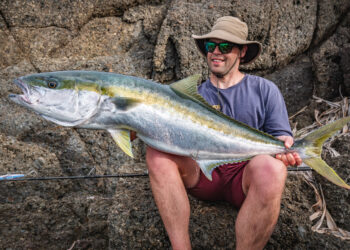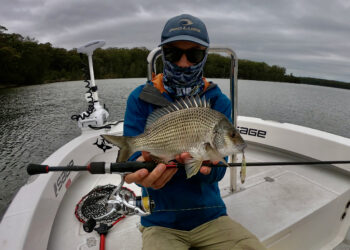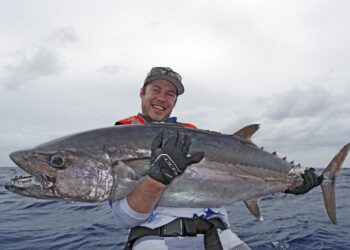
WHETHER you are fishing the open ocean chasing marlin or far up a remote river chasing barramundi trolling is a fishing method that you should be competent in. As a form of lure delivery it has a large number of advantages, the main one being that it lets you cover a lot of water in your search for fish. In the current Facebook and Instagram social media environment it is common to see a lot of the new breed of anglers become quite dismissive of trolling, sometimes proudly stating “I don’t troll”. This combination of arrogance and ignorance stems from a casting dominated approach to fishing that is dismissive of all the complexity, nuances and tactics required to be a good troller. But each to his own! The following is a guide to the general principles of effective trolling, regardless of species. For most species I’m equally happy to troll or cast, and in no way regard trolling as a secondary method.
Principle 1: The Zone of Convergence
This refers to how the boat and engine noise may affect the behaviour of the predatory fish you chase. It basically means how far behind the boat you should position your lures so the effect of the boat potentially scaring the fish is minimised and they feed in a normal way as if any disturbance has passed. Some species, such as marlin, actually are attracted to the boat wash and the teasers and lures towed behind it. My most effective lure position is called the “short corner” and is a lure that runs about 15 to 20 meters behind the boat just behind my teaser. For marlin the “Zone of Convergence” is very short. They are attracted to the boat and are fearless. In contrast, impoundment barramundi rarely eat a trolled lure close to the boat, and I generally position my lures between 50 and 80 metres back. Trolling using the electric motor reduces any engine noise and there is less disturbance to feeding fish. Every species seems to have a different behaviour when it comes to how they feed on trolled lures and it varies depending on the environment you are fishing in. In dirty Northern Territory Rivers barramundi will eat deep diving lures trolled relatively close to the boat.
When I am trolling offshore using skirted lures over 90 per cent of the bites on the short lures are from marlin. Dolphin fish and wahoo invariably eat the lures positioned further back from the outriggers or shot gun position. These fish have a longer “zone of convergence”. It is important to understand this concept. With some species such as impoundment barramundi it can make a huge difference to your results.
Another species I spend a lot of time chasing in winter and spring is flathead. While we spend most of the time casting, trolling is a method I use when the fish are scattered over wide areas. Flathead will eat a lure close to the boat, but in general I like my lure around thirty metres back. In shallow water it is not uncommon to spook a lot of fish that can be seen bursting out of the bottom in a muddy cloud, but if you put the lures back a bit the same fish will return to position and hit the lure.

Principle 2: It’s all about the bait!
Effective trolling is related to positioning your lures so they travel close to where the fish are feeding. If you find the bait you will find the fish. At the moment, off the Gold Coast, we have had one of the best runs of small black marlin seen in many years. These fish gorge themselves on big bait schools of slimy mackerel, pilchards and yellowtail, and when the bait is thick they are often hard to catch on a trolled lure. When there is a big bait school about 40 metres down surrounded by a dozen marlin they rarely rise to the top to eat a lure, and live baiting in these spots is generally much more effective. However, there are a few tactics that bring on bites. The first of which is to move away from the biggest bait balls and look for scattered bait. Mutton birds can be a great help in these situations. While they can’t feed on a bait school 40 metres below they are adept at hunting bait that may be five to 10 metres down, and this type of shallow broken up bait schools are ideal for lure trolling. Lures rarely catch as many fish as live baits, but it is a fun way to fish and I personally much prefer to fish this way. Birds are your sign posts in the sea.
I recently fished in Callide Dam near Biloela in Central Queensland. The fishing was quite tough and while this dam produces some monstrous barramundi, the feeding periods are quite short.
I was shown a method by Jason Ehrlich and it lead me to trying to work out exactly why this slow trolling plastic swim baits was so effective. The main baitfish in Callide Dam are bony bream, a native species rarely caught on a line. They are abundant in many dams and are the protein building blocks that make impoundment barramundi so huge. These unique little fish feed on detritus, a mix of algae, plankton and small insects. Like most impoundments, when Callide Dam is quite calm at dawn and dusk there are tiny insects in millions. These are only one or two millimetres long. If you wear a head torch you will soon find out about them! They don’t bite, but fall onto the water surface in huge numbers. When this happens, the bony bream start to roll on the surface, flicking and feeding across wide areas of the main basin of the dam. On the echo sounder it is easy to see the bony bream schools, followed by the barramundi, rise to the surface. This only happens in calm conditions. Trolling the wide expanse of the dam’s main basin using Zerek Live Mullets positioned around 80 metres back was stunningly effective and produced fish when hours of casting failed to get a bite. However, in windy conditions there are few if any bugs so the bony bream don’t rise to the surface and the fish don’t bite.
Similarly, when trolling for Murray cod and yellowbelly it is important to get your lure to a running depth so it is on or close to the bottom, as most of the food these species eat, such as yabbies, tends to be right on the bottom and this is where the fish expect their food to be. At times small spangled perch will feed on the surface, usually early in the morning. When this happens trolling swim baits and surface walkers under electric power can be very successful, and again, it works best if you put the lures well back behind the boat, running them at 60 to 80 metres. If you put the lure where the bait is holding you will have a lot more success.

Principle 3: Get your troll speed right!
All lures have an optimal working speed, and the illusion that the lure creates depends on the speed the lure moves at. Sometimes I troll specifically targeting wahoo at troll speeds of up to 15 knots using heavy metal headed skirted lures sold locally as “Hex Heads”. These appear as a blur of bubbles in the wake, and one of the traits of both wahoo and Spanish mackerel is that they aggressively chase and attack baitfish such as small tuna travelling at high speed. On some days, particularly in glassy conditions, you need a minimum speed of around 12 knots in order to be effective. While this is probably the most extreme example, optimising your troll speed is very important to get the best results. At the other extreme, trolling for species like Murray cod is best done at speeds of less than one knot. This effectively gets the lure to its running depth and keeps the lure in the strike zone for a longer period. Cod like slow lures!
When fishing offshore I troll at 7 to 8 knots for black marlin, 8 to 9 knots for blue marlin and around 12 knots for wahoo when using heavy weighted skirted lures. If I am trolling hard bodied lures for mackerel and other species I generally troll at around 6 knots. In contrast, when trolling in impoundments I like to work the lures slowly at only 1.5 to 2 knots in most situations. Every small minnow style lure has an optimal running speed where the running depth of the lure and its vibration are at their optimum performance.

Principle 4: Troll lures that all work at your designated troll speed.
What this means is that the lures you use together in a trolling ‘spread’ all run well at your designated trolling speed. If I am trolling for marlin all of the lures should bubble and froth at around 7 knots. If you mix lures designed to be trolled at 10 knots amongst your other lures they will be very limp and lack action at 7 knots. This takes a bit of practice. Skirted trolling lures all have an optimal speed. Some have large cup faces and push a lot of water in front of them. These lures tend to work well at slower speed and hold in the water surface well at relatively high speed. Longer narrower lure heads generally require a bit more speed to get them working well. I get about my marlin lures and constantly adjust the lure spread according to the conditions present.
The same applies to all types of trolling where multiple lines are used. With experience, it is easy to troll multiple lines when targeting fish such as flathead on the troll. If the lures are running in clean water and snags are not a problem (as occurs in most offshore situations), then multiple lines give you multiple chances and allow you to cover more water while giving the fish a greater selection to choose from.
In many trolling situations, such as when targeting barra in the big tidal rivers of the Northern Territory, a rod held in the hand works much better than a rod in a rod holder. In this situation it is important to work the lure, allowing it to back up over a snag, or drop back into the slot when you miss a hit. Most of the lures used in this type of trolling are buoyant deep divers worked close to the bottom and when they bump a log or rock, they can be free spooled back so they rise and can be brought over the snag easily. It is also an effective way to strike at bites.

Principle 5: Be patient and stick to the game plan!
Trolling is far more than dragging lures around in the vague hope of getting a bite. You need to be constantly environmentally aware, always on the look out for the smallest clue. Personally, I think there is a lot more challenge in mastering trolling than there is in endless casting. Constant surveillance of the echo sounder, careful attention to the action of the lures and working out the best troll runs are all a part of the game. It may look simple, but it becomes complex quickly! When the fishing is tough persistence pays off.
















